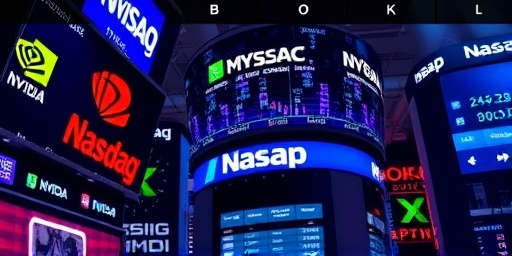The Nasdaq Composite index surged to a new all-time high on Friday, closing at 18,276.50 after a robust 2.5% gain, propelled by explosive performances from tech stocks amid the ongoing AI boom. Nvidia and Microsoft emerged as the undisputed leaders of this rally, with Nvidia’s shares jumping 4.2% and Microsoft’s climbing 3.1%, reflecting investor fervor for artificial intelligence innovations. This milestone comes as global AI investments are projected to exceed $200 billion in 2024, underscoring the sector’s transformative impact on financial markets.
Nvidia’s Semiconductor Supremacy Ignites Nasdaq Surge
At the forefront of the tech stocks rally was Nvidia, whose cutting-edge graphics processing units (GPUs) have become indispensable for AI training and deployment. The company’s stock not only drove the Nasdaq‘s ascent but also highlighted the depth of the AI boom. Nvidia reported quarterly revenues of $26 billion in its latest earnings, a staggering 262% increase year-over-year, largely attributed to demand for its H100 and upcoming Blackwell AI chips.
Analysts attribute Nvidia’s dominance to its near-monopoly in high-performance computing for AI applications. ‘Nvidia isn’t just riding the AI wave; it’s building the surfboard,’ said Wedbush Securities analyst Dan Ives in a recent note. The chipmaker’s market capitalization briefly touched $3.2 trillion, surpassing Apple as the world’s most valuable company, further cementing its role in elevating the Nasdaq.
Investors poured into Nvidia shares following announcements of partnerships with major cloud providers and automakers integrating AI into autonomous vehicles. For instance, Nvidia’s collaboration with Tesla for next-generation self-driving tech has sparked speculation of even greater gains. This enthusiasm spilled over, lifting related tech stocks like AMD, which rose 3.8%, and Broadcom, up 2.9%, creating a ripple effect across the semiconductor sector that bolstered the overall Nasdaq performance.
However, not all views are unanimously bullish. Some market watchers caution about valuation concerns, with Nvidia trading at a forward price-to-earnings ratio of 45, well above the Nasdaq average of 28. Despite this, the AI boom’s momentum appears unstoppable, with Nvidia’s innovations in generative AI tools like ChatGPT integrations driving sustained interest.
Microsoft’s AI Ambitions Propel Cloud Dominance
Complementing Nvidia’s hardware prowess, Microsoft showcased the software side of the AI boom, with its Azure cloud platform reporting a 31% revenue jump to $24.1 billion. The integration of OpenAI’s technologies into products like Microsoft Copilot has positioned the tech giant as a key player in enterprise AI adoption, directly contributing to the Nasdaq’s record-breaking day.
Microsoft’s CEO, Satya Nadella, emphasized during a recent earnings call that ‘AI is the runtime that will define the next era of computing.’ This vision materialized in stock gains as investors bet on Microsoft’s ability to monetize AI across its vast ecosystem, including Office 365 and Xbox gaming. The company’s investment of over $13 billion in OpenAI has yielded tangible results, with AI-enhanced features boosting user engagement by 20% in productivity tools.
The Nasdaq’s uptick was amplified by Microsoft’s role in the broader tech stocks landscape. Shares of fellow Magnificent Seven members, such as Amazon and Alphabet, also advanced, with Amazon’s AWS cloud services seeing AI-related growth of 17%. Microsoft’s steady climb reflects a maturing AI market where software and services are increasingly vital, moving beyond hype to practical implementations in industries like healthcare and finance.
Regulatory scrutiny looms as a potential headwind, with antitrust probes into Microsoft’s OpenAI ties gaining traction in Europe. Yet, these concerns were overshadowed by positive data: Microsoft’s AI-driven revenue streams are expected to contribute an additional $10 billion annually by 2025, fueling optimism that propelled the Nasdaq higher.
AI Investments Fuel Broader Tech Stocks Momentum
The AI boom extended its influence beyond Nvidia and Microsoft, invigorating a wide array of tech stocks and pushing the Nasdaq Composite to uncharted territory. Smaller players in AI infrastructure, such as Palantir Technologies and Snowflake, posted gains of over 5%, as enterprises ramp up data analytics capabilities powered by artificial intelligence.
Market data from Bloomberg indicates that AI-themed exchange-traded funds (ETFs) like the Global X Robotics & Artificial Intelligence ETF surged 3.2%, attracting $1.5 billion in inflows last week alone. This capital influx underscores how the AI boom is reshaping investment strategies, with venture capital firms deploying $50 billion into AI startups in the first half of 2024, per PitchBook research.
In the Nasdaq’s ecosystem, sectors like cybersecurity and fintech benefited indirectly. CrowdStrike, despite recent challenges, rebounded 2.1% on AI-enhanced threat detection announcements, while fintech firm Affirm Holdings climbed 4% amid AI personalization trends in lending. The index’s technology-heavy composition—over 50% of its weight—made it particularly sensitive to these developments, resulting in the 2.5% leap that outpaced the S&P 500’s modest 1.2% gain.
Global factors also played a role, with Asian tech markets echoing the rally as Taiwan Semiconductor Manufacturing Co. (TSMC), a key Nvidia supplier, reported record orders. This interconnectedness highlights the Nasdaq’s position as a barometer for the AI boom’s worldwide reach, drawing in institutional investors seeking exposure to high-growth opportunities.
Analysts Forecast Sustained Nasdaq Gains Through 2026
Looking ahead, experts are overwhelmingly positive about the Nasdaq’s trajectory, predicting the index could reach 22,000 by the end of 2026, driven by escalating AI investments. Goldman Sachs strategists raised their year-end target to 19,500, citing ‘unprecedented productivity gains from AI adoption across industries.’
‘The AI boom is not a bubble; it’s a structural shift,’ remarked Mary Erdoes, CEO of J.P. Morgan Asset Management. Her firm anticipates annual AI spending to hit $300 billion by 2026, with tech stocks like Nvidia poised to capture a significant share. JPMorgan’s models project Nvidia’s revenue doubling again in 2025, supported by demand from hyperscale data centers.
Challenges persist, including supply chain bottlenecks for advanced chips and geopolitical tensions affecting rare earth materials. The U.S.-China trade dynamics could impact Nvidia’s exports, potentially capping short-term gains. Nonetheless, diversification into edge AI and quantum computing offers new avenues for growth, as evidenced by recent prototypes from IBM and Google.
Retail investors, empowered by platforms like Robinhood, are piling in, with AI-related trades up 40% month-over-month according to recent surveys. This grassroots enthusiasm, combined with institutional backing, suggests the Nasdaq’s AI-fueled ascent has legs, potentially reshaping economic landscapes for years to come.
As the market digests these highs, attention turns to upcoming Federal Reserve decisions on interest rates, which could either amplify or temper the tech stocks rally. With AI innovations accelerating— from drug discovery at Pfizer to personalized education via Duolingo—the Nasdaq stands as a testament to technology’s enduring power. Investors eyeing long-term positions in Nvidia and peers may find the current momentum a strategic entry point, with forecasts pointing to compounded annual growth rates exceeding 15% through 2026.









